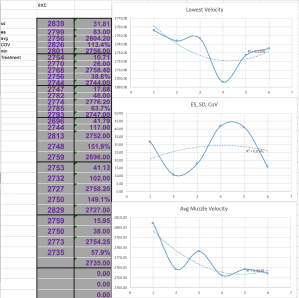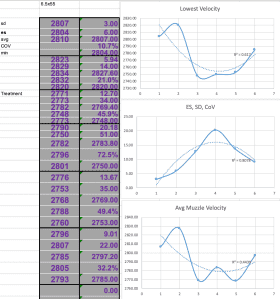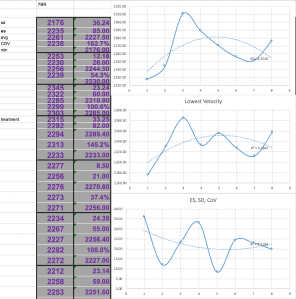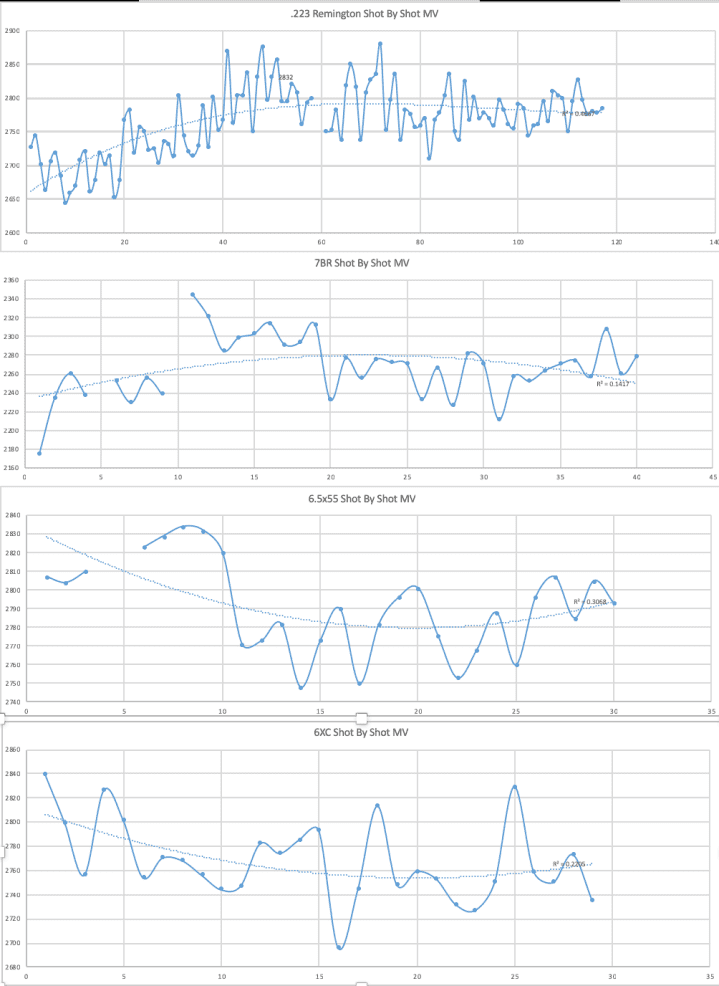BallisticsGuy
Well-Known Member
I am not affiliated in any way with Modern Spartan Systems. I wanted to do a big test, found MSS making some pretty bold claims and so this was the big test I chose. Coach and I are funding it on our own dimes and times. As such, you won't get marketing. Just our opinions and cold hard facts.
Modern Spartan Systems has entered the market with cleaning and lubrication products which promise "green" technology, advanced chemistry, superior effectiveness and most interestingly: increases in muzzle velocity, reductions of group sizes and extending of barrel life. Well, I just can't let an opportunity for a Pepsi Challenge like that go without tossing my thing in the ring. So, I rang up Coach and told him we're going to burn some ammo and do some fun testing. He was not excited. He's danced to this music before.
We've gone ahead and obtained a complete set of MSS's chemical offerings (even their engine additive, I'm testing that in my hybrid now) and have begun the process of getting the tests setup and carried out. There's a lot of prep involved but I'll spare you the details for now.
MSS's Accuracy Oil passed the Timken bearing challenge which so wonderfully few lubricants have done. We're curious about that and what it actually means to us and our guns but equally curious about the possibility of a highly effective cleaning system that doesn't stink to high Heaven or make the slightest nick on your finger feel like it was just napalmed. The exposed finger cut thing we got a test on right away because I'm a fool for having little cuts all over the place on my hands. It's not punishing level of pain at least in that regard. Some of the chemicals have a little sting to them but mostly it wasn't enough to even blow on my fingers over.
Moving on. We've gathered up a number of match rifles and plinking rifles. We've gathered defense pistols and target pistols. We've got trap shotguns and hunting shotguns. We've got high end optics, mid range optics and low end optics. We're even bringing a small cannon, an antique Trapdoor Springfield and a new manufacture reproduction Sharps rifle in .45-70. We've got rimfire, centerfire and even Bic-fire. We're running chamberings that take everything from black powder to fast pistol powder to slow pistol powder to fast and slow rifle powders. We've got magnum and non-magnum primers in use. We've really done our level best to select a test subject from as many of the conceivably useful combinations of all of the above as possible.
MV Testing: We apply the entire MSS cleaning system as directed including conditioning the bore with Accuracy Oil. We compare pre-cleaning (dirty bore) velocity averages, standard deviation, coefficient of variation, minimum and maximum with data from conditioning phase and post-conditioning phase data. Data is tracked and logged for each string as well as for each individual shot. Strings are 3-5 shots. 5 shots is the standard. 3 shots is used only where barrel heat becomes an issue during testing. Magnetospeed chronographs are used throughout except for the black powder bits. With black powder we've had better luck with a Labradar.
Accuracy/Precision Testing: We track group size for each string of fire during MV initial testing. After the barrels reach copper equilibrium and bench gathered data is of sufficient volume (where velocities and group sizes seem to stabilize and we have at least several 5-shot strings of velocity data post-treatment) we take the guns into competition because, hey, we are competitive shooters and that's where the metal meets the meat (figuratively speaking). Match scores with MSS treated rifles are compared against past match performance (we have books full of our match scores).
Barrel Life: We have obtained 2 identical Columbia River Arms barrels chambered in 6mm XC. Both are chambered with the same reamer on the same lathe by the same gunsmith in the same week. Extra care was used in selecting a custom reamer and machinist gunsmith capable of the required precision to minimize tolerances like run-out. Both barrels are being put into our existing match rifles. Both rifles will shoot the same load spec (this makes load development unnecessarily tricky but we'll deal with it). Loads will use the same lot of brass/powder/primers/bullets and both will used only HBN coated DTAC bullets from David Tubb. One barrel will be treated with MSS's system from the beginning, the other will not. After every 200 rounds we'll re-clean & re-treat the treated barrel. On the control barrel we'll clean every 200 rounds with Wipe-Out (which we prefer over Hoppe's #9 & Sweet's 7.62). We'll track the barrel life via throat erosion pace, velocity retention and group size until we have a clear winner. We estimate it will take 1000 rounds to get to a useful answer.
What we see with the 7mm BR, the 6mm XC and the 6.5×55 Swede so far is very similar to what we saw during the early phases with the .223. A lot of volatility during the treatment phase followed by what appears to be (NOTE: APPEARS TO BE, these are early results, too early for real conclusions) some stabilization. What we have not seen are dramatic, sticky (meaning that the effect persists) increases in MV. If anything what we see are slight reductions in peak velocity and slight increases in minimum velocity. That's an increase of consistency which any shooter would gladly take over any token velocity increase.
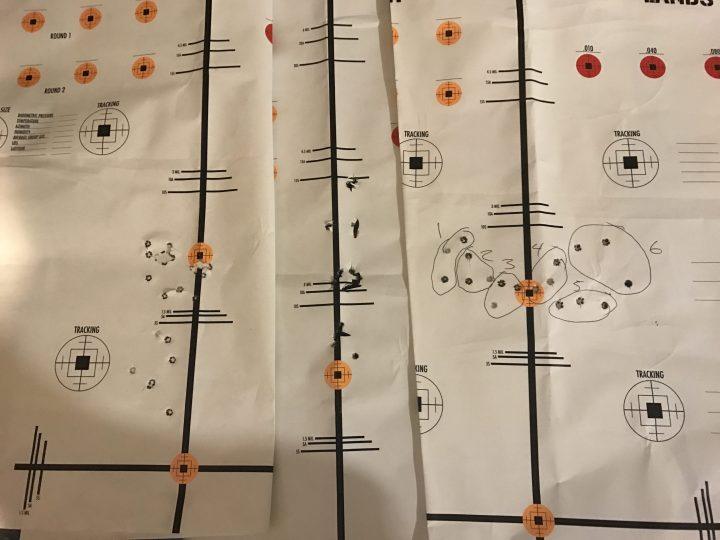
As you move up and to the right you'll see progression. Groups at bottom and left are at the beginning of treatment. Top and right are end of treatment. L-.223,M-6XC,R-7mmBR
What we did see pretty universally (only the 7mm BR didn't improve) is a reduction in group size. Could this be a rebuke of our usual blanket advice to avoid unnecessarily cleaning a rifle? Maybe. It could also be due to more consistent friction leading to more consistent harmonics. It could be the stars aligning. Part of our usual advice to clean as infrequently as possible is economics based. It takes a good number of shots (so far it's looking like at least 5-10 and as much as 40+ in some cases) for a barrel to get to copper fouling equilibrium. Who's needing to burn 40 rounds more every time they clean just because they cleaned. Part of it is based on the notion that most rifle barrel wear out in the real world of sport shooters comes from overly aggressive and overly frequent cleaning. We do things both ways in reality. Our metallic silhouette rifles mostly get cleaned after every 100-200 rounds (except my red gun). Our PRS/prone guns historically get cleaned almost never… like every 400 rounds or so.
What do you think we'll see as results continue to trickle in? Comment below!
Modern Spartan Systems has entered the market with cleaning and lubrication products which promise "green" technology, advanced chemistry, superior effectiveness and most interestingly: increases in muzzle velocity, reductions of group sizes and extending of barrel life. Well, I just can't let an opportunity for a Pepsi Challenge like that go without tossing my thing in the ring. So, I rang up Coach and told him we're going to burn some ammo and do some fun testing. He was not excited. He's danced to this music before.
We've gone ahead and obtained a complete set of MSS's chemical offerings (even their engine additive, I'm testing that in my hybrid now) and have begun the process of getting the tests setup and carried out. There's a lot of prep involved but I'll spare you the details for now.
MSS's Accuracy Oil passed the Timken bearing challenge which so wonderfully few lubricants have done. We're curious about that and what it actually means to us and our guns but equally curious about the possibility of a highly effective cleaning system that doesn't stink to high Heaven or make the slightest nick on your finger feel like it was just napalmed. The exposed finger cut thing we got a test on right away because I'm a fool for having little cuts all over the place on my hands. It's not punishing level of pain at least in that regard. Some of the chemicals have a little sting to them but mostly it wasn't enough to even blow on my fingers over.
Moving on. We've gathered up a number of match rifles and plinking rifles. We've gathered defense pistols and target pistols. We've got trap shotguns and hunting shotguns. We've got high end optics, mid range optics and low end optics. We're even bringing a small cannon, an antique Trapdoor Springfield and a new manufacture reproduction Sharps rifle in .45-70. We've got rimfire, centerfire and even Bic-fire. We're running chamberings that take everything from black powder to fast pistol powder to slow pistol powder to fast and slow rifle powders. We've got magnum and non-magnum primers in use. We've really done our level best to select a test subject from as many of the conceivably useful combinations of all of the above as possible.
Test Protocols:
Variable Controls: We've selected a single load specification for each gun to complete testing with. Air temperature/humidity/pressure/wind are kept as stable as possible. Guns are not shot hot (when hot to the touch we take a break in testing to cool it off naturally). MV Testing: We apply the entire MSS cleaning system as directed including conditioning the bore with Accuracy Oil. We compare pre-cleaning (dirty bore) velocity averages, standard deviation, coefficient of variation, minimum and maximum with data from conditioning phase and post-conditioning phase data. Data is tracked and logged for each string as well as for each individual shot. Strings are 3-5 shots. 5 shots is the standard. 3 shots is used only where barrel heat becomes an issue during testing. Magnetospeed chronographs are used throughout except for the black powder bits. With black powder we've had better luck with a Labradar.
Accuracy/Precision Testing: We track group size for each string of fire during MV initial testing. After the barrels reach copper equilibrium and bench gathered data is of sufficient volume (where velocities and group sizes seem to stabilize and we have at least several 5-shot strings of velocity data post-treatment) we take the guns into competition because, hey, we are competitive shooters and that's where the metal meets the meat (figuratively speaking). Match scores with MSS treated rifles are compared against past match performance (we have books full of our match scores).
Barrel Life: We have obtained 2 identical Columbia River Arms barrels chambered in 6mm XC. Both are chambered with the same reamer on the same lathe by the same gunsmith in the same week. Extra care was used in selecting a custom reamer and machinist gunsmith capable of the required precision to minimize tolerances like run-out. Both barrels are being put into our existing match rifles. Both rifles will shoot the same load spec (this makes load development unnecessarily tricky but we'll deal with it). Loads will use the same lot of brass/powder/primers/bullets and both will used only HBN coated DTAC bullets from David Tubb. One barrel will be treated with MSS's system from the beginning, the other will not. After every 200 rounds we'll re-clean & re-treat the treated barrel. On the control barrel we'll clean every 200 rounds with Wipe-Out (which we prefer over Hoppe's #9 & Sweet's 7.62). We'll track the barrel life via throat erosion pace, velocity retention and group size until we have a clear winner. We estimate it will take 1000 rounds to get to a useful answer.
The Guns:
We'll be testing with all of these as time goes on. The first test was with 4 rifles and 4 pistols.
Glock 21: As issued with Lone Wolf barrel.
Springfield XD 45 Tactical: As issued.
Dan Wesson 15-4: As issued.
Ruger MkIII Target Competition: As issued.
Colt 1911 Series 70: As issued.
Mossberg MVP .223: 26" Columbia River Arms 1:7 barrel, LSS chassis, Timney Trigger, A2 flash hider, XLR Butt Stock, DPMS PSG-1 Grip, US Optics SN3 3.8-22x44
7mm BR: 24" Savage 110, Nesika Bay stock, Weaver T24, Hart 1:10 barrel
6.5x55 Swede: Rem 700, Mark Pharr stock, Jewel trigger, 24" Krieger Barrel, Nikon M3 6-24x
6mm XC: Savage 110, custom stock, Canjar trigger, 26" Columbia River Arms 1:8 barrel, US Optics SN3 3.8-22x44
6mm XC: Savage 10FPSR, LSS chassis, XLR butt stock, MOE grip, 26" Columbia River Arms barrel, US Optics SN3 3.8-22x58
1" Howitzer: 1" X 5 calibers black powder howitzer
Trapdoor Springfield: As issued, 1884 Cleaning Rod Bayonet model
Sharps Rifle: Pedersoli Reproduction, 31" barrel, tang sight.
Anschutz 54: Custom, 20" barrel, Weaver 36x scope
Sako Finnfire: As issued. Nikon 6-24x
M1 Garand: As issued.
M1 Carbine: As issued
AR-15: PSA 16" M4 Upper, NFA Lower, 3-9x37mm 60's era FFP optic
Remington 1900: 12ga 30" trap barrels
Stevens SxS: 16ga 26" barrels
Mossberg 500: 12ga 20" barrel
We'll be testing with all of these as time goes on. The first test was with 4 rifles and 4 pistols.
Glock 21: As issued with Lone Wolf barrel.
Springfield XD 45 Tactical: As issued.
Dan Wesson 15-4: As issued.
Ruger MkIII Target Competition: As issued.
Colt 1911 Series 70: As issued.
Mossberg MVP .223: 26" Columbia River Arms 1:7 barrel, LSS chassis, Timney Trigger, A2 flash hider, XLR Butt Stock, DPMS PSG-1 Grip, US Optics SN3 3.8-22x44
7mm BR: 24" Savage 110, Nesika Bay stock, Weaver T24, Hart 1:10 barrel
6.5x55 Swede: Rem 700, Mark Pharr stock, Jewel trigger, 24" Krieger Barrel, Nikon M3 6-24x
6mm XC: Savage 110, custom stock, Canjar trigger, 26" Columbia River Arms 1:8 barrel, US Optics SN3 3.8-22x44
6mm XC: Savage 10FPSR, LSS chassis, XLR butt stock, MOE grip, 26" Columbia River Arms barrel, US Optics SN3 3.8-22x58
1" Howitzer: 1" X 5 calibers black powder howitzer
Trapdoor Springfield: As issued, 1884 Cleaning Rod Bayonet model
Sharps Rifle: Pedersoli Reproduction, 31" barrel, tang sight.
Anschutz 54: Custom, 20" barrel, Weaver 36x scope
Sako Finnfire: As issued. Nikon 6-24x
M1 Garand: As issued.
M1 Carbine: As issued
AR-15: PSA 16" M4 Upper, NFA Lower, 3-9x37mm 60's era FFP optic
Remington 1900: 12ga 30" trap barrels
Stevens SxS: 16ga 26" barrels
Mossberg 500: 12ga 20" barrel
Initial Rifle Results
What we see with the .223; which has the most shots through it since treatment, is that MV's have stabilized. Group size average during treatment was over 1 inch. After treatment group size for a 10-shot string was .7 inch. SD's were dropped roughly in half. Minimum string velocity (a component of velocity extreme spread) increased substantially without a sympathetic change in maximum string velocity as well. A gun/load combination that was getting on my nerves is now showing signs of being a potential sweetheart. After another hundred rounds or so we'll be ready to look toward some conclusion drawing on the .223 Mossberg MVP.What we see with the 7mm BR, the 6mm XC and the 6.5×55 Swede so far is very similar to what we saw during the early phases with the .223. A lot of volatility during the treatment phase followed by what appears to be (NOTE: APPEARS TO BE, these are early results, too early for real conclusions) some stabilization. What we have not seen are dramatic, sticky (meaning that the effect persists) increases in MV. If anything what we see are slight reductions in peak velocity and slight increases in minimum velocity. That's an increase of consistency which any shooter would gladly take over any token velocity increase.

As you move up and to the right you'll see progression. Groups at bottom and left are at the beginning of treatment. Top and right are end of treatment. L-.223,M-6XC,R-7mmBR
What we did see pretty universally (only the 7mm BR didn't improve) is a reduction in group size. Could this be a rebuke of our usual blanket advice to avoid unnecessarily cleaning a rifle? Maybe. It could also be due to more consistent friction leading to more consistent harmonics. It could be the stars aligning. Part of our usual advice to clean as infrequently as possible is economics based. It takes a good number of shots (so far it's looking like at least 5-10 and as much as 40+ in some cases) for a barrel to get to copper fouling equilibrium. Who's needing to burn 40 rounds more every time they clean just because they cleaned. Part of it is based on the notion that most rifle barrel wear out in the real world of sport shooters comes from overly aggressive and overly frequent cleaning. We do things both ways in reality. Our metallic silhouette rifles mostly get cleaned after every 100-200 rounds (except my red gun). Our PRS/prone guns historically get cleaned almost never… like every 400 rounds or so.
What do you think we'll see as results continue to trickle in? Comment below!

